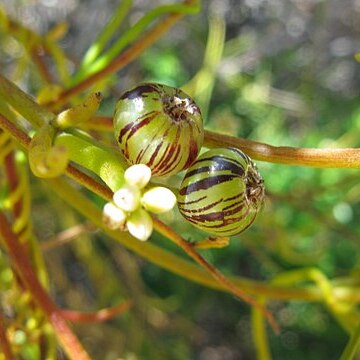Stem (0.9–) 1.3–2 (–4) mm thick, glabrescent, green to reddish green. Young shoots pubescent. Inflorescence a spike, (1–) 6–9 (–13)-flowered, single or rarely clustered; peduncles (8–) 20–30 (–95) × 0.8–1.5 mm, usually darker than stem, covered with white and red, short retrorse hairs. Floral bracts whorled; bract triangular, c. 1 × 1–1.4 mm, with hairs short, reddish, appressed, spreading; bracteoles deltoid-ovate, 0.5–0.6 × 0.7–0.9 mm, with similar indumentum. Flowers ovate, 2–3 × 1.3–2 mm, subsessile to sessile. Sepals deltoid, 1–1.3 × c. 1 mm, pubescent. Petals ovate, acute, 1.9–2.7 × 1.3–1.9 mm, pubescent on both sides with short, thick, retrorse, appressed black hairs, pubescence outside basally often reddish. Fertile stamens 9. Staminodes obcordate, c. 0.7 × c. 0.4 mm, shortly stalked, white, turning brown; gland ovoid, somewhat angular to hexagonal, c. 0.5 × 0.2–0.3 mm. Ovary fusiform, c. 2 × 0.5 mm, glabrous. Fruit globular, 10–15 mm across, glabrescent, light green to cream-white, usually drying black, 7–10 mm across.
More
It is a tough twining plant that lives off other plants. It keeps growing from year to year. It can grow 9 m high and spread 3-4 m wide. It appears to be leafless. The flowers are very small and white. They are less than 10 mm across. The fruit are fleshy berries. They are round, green and without hairs. They become black at maturity.

